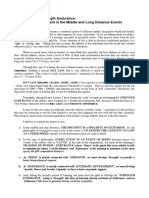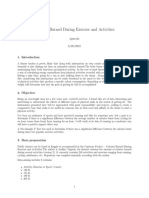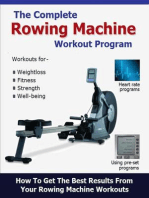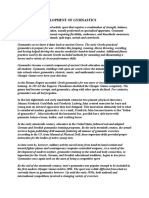0 ratings0% found this document useful (0 votes)
29 viewsEstimating Energy Expenditure
Estimating Energy Expenditure
Uploaded by
Lukas RenannThis document provides information on estimating energy expenditure during exercise using MET levels and formulas. It includes a table listing common activities along with their MET levels to indicate intensity. The summary is:
1) To estimate calories burned during exercise, you need to know your weight and the MET level of the activity from the provided table.
2) A formula is given to calculate calories burned per minute by multiplying MET level, weight in kilograms, and a constant.
3) For a more accurate calorie deficit calculation, subtract calories that would have been burned at rest for the same time period. This provides the amount of calories available for fat loss.
Copyright:
© All Rights Reserved
Available Formats
Download as PDF, TXT or read online from Scribd
Estimating Energy Expenditure
Estimating Energy Expenditure
Uploaded by
Lukas Renann0 ratings0% found this document useful (0 votes)
29 views2 pagesThis document provides information on estimating energy expenditure during exercise using MET levels and formulas. It includes a table listing common activities along with their MET levels to indicate intensity. The summary is:
1) To estimate calories burned during exercise, you need to know your weight and the MET level of the activity from the provided table.
2) A formula is given to calculate calories burned per minute by multiplying MET level, weight in kilograms, and a constant.
3) For a more accurate calorie deficit calculation, subtract calories that would have been burned at rest for the same time period. This provides the amount of calories available for fat loss.
Original Description:
GASTO ENERGÉTICO
Original Title
estimating-energy-expenditure
Copyright
© © All Rights Reserved
Available Formats
PDF, TXT or read online from Scribd
Share this document
Did you find this document useful?
Is this content inappropriate?
This document provides information on estimating energy expenditure during exercise using MET levels and formulas. It includes a table listing common activities along with their MET levels to indicate intensity. The summary is:
1) To estimate calories burned during exercise, you need to know your weight and the MET level of the activity from the provided table.
2) A formula is given to calculate calories burned per minute by multiplying MET level, weight in kilograms, and a constant.
3) For a more accurate calorie deficit calculation, subtract calories that would have been burned at rest for the same time period. This provides the amount of calories available for fat loss.
Copyright:
© All Rights Reserved
Available Formats
Download as PDF, TXT or read online from Scribd
Download as pdf or txt
0 ratings0% found this document useful (0 votes)
29 views2 pagesEstimating Energy Expenditure
Estimating Energy Expenditure
Uploaded by
Lukas RenannThis document provides information on estimating energy expenditure during exercise using MET levels and formulas. It includes a table listing common activities along with their MET levels to indicate intensity. The summary is:
1) To estimate calories burned during exercise, you need to know your weight and the MET level of the activity from the provided table.
2) A formula is given to calculate calories burned per minute by multiplying MET level, weight in kilograms, and a constant.
3) For a more accurate calorie deficit calculation, subtract calories that would have been burned at rest for the same time period. This provides the amount of calories available for fat loss.
Copyright:
© All Rights Reserved
Available Formats
Download as PDF, TXT or read online from Scribd
Download as pdf or txt
You are on page 1of 2
CU SPORTS MEDICINE
Estimating Energy Expenditure
To estimate how many calories you’ll burn during exercise, you need to know your weight and the
MET level of an activity. (You can get the MET level of an activity from the table below). MET means
metabolic equivalent and is the amount of energy you expend and oxygen you consume. One MET is
the amount of energy you expend while sitting. When you exercise, your MET level increases because
your working muscles need more energy and oxygen. Use the following formula to calculate how
many calories per minute you will burn during the activity. Then multiply that number by your total
exercise minutes.
Energy expenditure (calories/minute) = .0175 x MET (from chart) x weight (in kilograms)
(To find out your weight in kilograms, simply divide your weight in pounds by 2.2.)
To get a more accurate idea of how fast you’ll burn calories to lose weight:
Figure out what you would have burned if you were just sitting around, instead of exercising, for
the same time period. (The MET for sitting is 1.0.)
Subtract these calories from your exercise calories.
This is your energy deficit, or the amount of calories you can count on for fat loss. You will notice that
vigorous intensity exercise gives faster results.
METS Activity Description
1.0 Sitting Resting metabolic rate
4.0 Bicycling <l0 mph, general leisure
6.0 Bicycling 10-11.9 mph, leisure, slow, light effort
8.0 Bicycling 12-13.9 mph, leisure, moderate effort
10.0 Bicycling 14-15.9 mph, racing, fast, vigorous effort
12.0 Bicycling 16-19 mph, racing/not drafting or >19 mph drafting, very fast
16.0 Bicycling >20 mph, racing, not drafting
3.0 Cycling (stationary) 50 watts, very light effort
5.5 Cycling (stationary) 100 watts, light effort
7.0 Cycling (stationary) 150 watts, moderate effort
10.5 Cycling (stationary) 200 watts, vigorous effort
12.5 Cycling (stationary) 250 watts, very vigorous effort
4.5 Calisthenics home exercise, light or moderate effort
8.0 Calisthenics vigorous effort (pushups, pull-ups, sit-ups)
6.0 Dancing aerobic, ballet or modem
5.0 Dancing low impact aerobic
7.0 Dancing high impact aerobic
1.0 Inactivity Sitting quietly, watching TV., reading, talking on phone, riding in a car
1.2 Inactivity Standing quietly
8.0 Running 5 mph (12 min mile)
(OVER)
METS Activity Description
9.0 Running 5.2 mph (11.5 min mile)
10.0 Running 6 mph (10 min mile)
11 Running 6.7 mph (9 min m mile)
11.5 Running 7 mph (8.5 min mile)
12.5 Running 7.5 mph (8 min mile)
13.5 Running 8 mph (7.5 min mile)
14.0 Running 8.6 mph (7 min mile)
15.0 Running 9 mph (6.5 min mile)
16.0 Running 10 mph (6 min mile)
18.0 Running 10.9 mph (5.5 min mile)
15.0 Running Running stairs
8.5 Rowing machine 150 watts, vigorous effort
12.0 Rowing machine 200 watts, very vigorous effort
7.0 Skiing, X-country 2.5 mph, slow or light effort, ski walking
8.0 Skiing, X-country 4.0-4.9 mph, moderate speed and effort
9.0 Skiing, X-country 5.0-7.9 mph, brisk speed, vigorous effort
14.0 Skiing, X-country >8 mph, racing
16.5 Skiing, X-country hard snow, uphill, maximum effort
5.0 Skiing, downhill light effort
6.0 Skiing, downhill moderate effort
8.0 Skiing, downhill vigorous effort, racing
4.2 & 4.4 Stairmaster 4000PT & 4400 PT manual program level 2 (number of lights)
5.8 & 6.5 Stairmaster 4000PT & 4400 PT manual program level 4 (number of lights)
7.3 & 8.6 Stairmaster 4000PT & 4400 PT manual program level 6 (number of lights)
8.9 & 10.7 Stairmaster 4000PT & 4400 PT manual program level 8 (number of lights)
10.4 & 12.7 Stairmaster 4000PT & 4400 PT manual program level 10 (number of lights)
12.1 & 14.8 Stairmaster 4000PT & 4400 PT manual program level 12 (number of lights)
13.6 & 16.9 Stairmaster 4000PT & 4400 PT manual program level 14 (number of lights)
5.0 Stairmaster Stepmill 7000 PT exercise stage 2
7.0 Stairmaster Stepmill 7000 PT exercise stage 4
9.0 Stairmaster Stepmill 7000 PT exercise stage 6
11.0 Stairmaster Stepmill 7000 PT exercise stage 8
13.0 Stairmaster Stepmill 7000 PT exercise stage 10
15.0 Stairmaster Stepmill 7000 PT exercise stage 12
17.0 Stairmaster Stepmill 7000 PT exercise stage 14
6.0 Swimming leisurely, not lap swimming
8.0 Swimming Backstroke, general
10.0 Swimming Breaststroke, general
11.0 Swimming Butterfly, general
2.5 Walking 2 mph, level slow pace, firm surface
3.0 Walking 2.5 mph, firm surface
3.5 Walking 3 mph, level, moderate pace, firm surface
4.0 Walking 3.5 - 4 mph, level, brisk, firm surface
4.5 Walking 4.5 mph, level, firm surface, very very brisk
6.5 Walking race walking
December 2004 (Reviewed 011/09) 2004, University of Colorado Hospital, Denver
EstExExp_SM DOD:PED02181
You might also like
- Capsim Capstone - Best Strategy - COMPETITION 5.0Document74 pagesCapsim Capstone - Best Strategy - COMPETITION 5.0Jared FenleyNo ratings yet
- 10K Training Program-MetricDocument1 page10K Training Program-MetricJairo Alexander100% (2)
- WaistAway30 - Training GuideDocument74 pagesWaistAway30 - Training GuideCosmin Dospinescu100% (2)
- Nike Run Club Half Marathon Training Plan Audio Guided Runs PDFDocument32 pagesNike Run Club Half Marathon Training Plan Audio Guided Runs PDFSpirulina UnoNo ratings yet
- Nike Run Club 5K Training PlanDocument25 pagesNike Run Club 5K Training PlanSalvador50% (2)
- Treadmill Workouts For Basketball PlayersDocument11 pagesTreadmill Workouts For Basketball Playerseretria100% (2)
- Nike Run Club 10K Training Plan Audio Guided Runs PDFDocument25 pagesNike Run Club 10K Training Plan Audio Guided Runs PDFSpirulina UnoNo ratings yet
- NIKE Half Marathon TrainingDocument32 pagesNIKE Half Marathon Trainingmanon100% (5)
- Coaching Youth Football PDFDocument251 pagesCoaching Youth Football PDFsaid100% (1)
- Renato Canova Development of Strengthy EnduranceDocument12 pagesRenato Canova Development of Strengthy EnduranceDarwins Mendoza100% (1)
- 10k Workouts and How To Progress ThemDocument4 pages10k Workouts and How To Progress ThemAna Duran100% (1)
- Holiday Island Guide PDFDocument6 pagesHoliday Island Guide PDFKyle PerezNo ratings yet
- Paleo 30 Day Meal Plan PDFDocument59 pagesPaleo 30 Day Meal Plan PDFTano43100% (5)
- Monthly Weight Loss Log Excel Template Personal Information WeightDocument6 pagesMonthly Weight Loss Log Excel Template Personal Information WeightAvel ChandNo ratings yet
- Levels of Common Recreational Activities: What Is A MET?Document2 pagesLevels of Common Recreational Activities: What Is A MET?MOHD SHAHRIZAL CHE JAMELNo ratings yet
- Postoperative Physiotherapy ManagementDocument11 pagesPostoperative Physiotherapy ManagementMohammed BadieNo ratings yet
- How Many Calories Am I Burning When I ExerciseDocument4 pagesHow Many Calories Am I Burning When I ExerciseagnihotrisonalNo ratings yet
- Cool Running - Competitive 10K ProgramDocument2 pagesCool Running - Competitive 10K ProgramSam SelinNo ratings yet
- 10K-HALF MARATHON RUNNING PLAN - SCC x RUNNING YOU CAN DODocument19 pages10K-HALF MARATHON RUNNING PLAN - SCC x RUNNING YOU CAN DOevyturinaNo ratings yet
- Step - Conversion.chart Walking, ExerciseDocument2 pagesStep - Conversion.chart Walking, Exerciseinfinitee00100% (1)
- The 20-Minute, 300-Calorie Treadmill ChallengeDocument3 pagesThe 20-Minute, 300-Calorie Treadmill ChallengeEmily PitreNo ratings yet
- 5K-10K RUNNING PLAN - SCC x RUNNING YOU CAN DODocument13 pages5K-10K RUNNING PLAN - SCC x RUNNING YOU CAN DOevyturinaNo ratings yet
- Trainingguide Marathon Beginner12 WeekDocument3 pagesTrainingguide Marathon Beginner12 WeekDiana TeiwazNo ratings yet
- Trainingguide Marathon Intermediate12 WeekDocument3 pagesTrainingguide Marathon Intermediate12 WeekHaswin FajrinNo ratings yet
- Half Marathon Ebook 1 1Document31 pagesHalf Marathon Ebook 1 1yuanyock915No ratings yet
- Here Is A Table of MET Values For Many Popular ActivitiesDocument3 pagesHere Is A Table of MET Values For Many Popular ActivitiesAndik RohmanaNo ratings yet
- Endurance Stamina 2.0Document16 pagesEndurance Stamina 2.0Guillermo OrtizNo ratings yet
- MetsDocument2 pagesMetssupreme_bangirasNo ratings yet
- MAPS Performance, Phase IIIDocument4 pagesMAPS Performance, Phase IIImathieuchristophe1993No ratings yet
- 8 Week Blitz Duathlon Training Plan PDFDocument4 pages8 Week Blitz Duathlon Training Plan PDFMatthew PettusNo ratings yet
- Calories Burned During Exercise and Activities RMDDocument20 pagesCalories Burned During Exercise and Activities RMDRomina JaramilloNo ratings yet
- S&A Session 2Document3 pagesS&A Session 2Richard CavagnolNo ratings yet
- Sprint Training For Distance RunnersDocument5 pagesSprint Training For Distance Runnersmelmel81100% (2)
- Kebutuhan Energi Status GiziDocument35 pagesKebutuhan Energi Status Gizitrihari wulyaniNo ratings yet
- HERE IS OUT TOP 4 SESSIONS of TREADMILLDocument6 pagesHERE IS OUT TOP 4 SESSIONS of TREADMILLAbdulWahidNo ratings yet
- Mayhem Athlete Aerobic Capacity E-BookDocument7 pagesMayhem Athlete Aerobic Capacity E-BookPedro RamosNo ratings yet
- R Canova 800 Metri (4 PG)Document4 pagesR Canova 800 Metri (4 PG)Demetrio FrattarelliNo ratings yet
- HIITDocument6 pagesHIITjatinsoni22092007No ratings yet
- Treadmill Workouts For Basketball PlayersDocument11 pagesTreadmill Workouts For Basketball PlayerseretriaNo ratings yet
- Kul 11 - Kebutuhan Energi Status GiziDocument35 pagesKul 11 - Kebutuhan Energi Status GiziAdelsy Dapa NgailoNo ratings yet
- Maps Performance Phase I Blueprint v5Document4 pagesMaps Performance Phase I Blueprint v5jnccumigadNo ratings yet
- 10 Tips To Improve Acceleration and Sprinting Speed PDFDocument22 pages10 Tips To Improve Acceleration and Sprinting Speed PDFSalman khanNo ratings yet
- Crank It Up - SprintingDocument13 pagesCrank It Up - SprintingAnonymous OAEuN9NE1s100% (4)
- Nike Run Club 10K Training Plan PDFDocument25 pagesNike Run Club 10K Training Plan PDFGeronimo GerezNo ratings yet
- Nike Chicago Marathon 2021 Training Plan - FinalDocument35 pagesNike Chicago Marathon 2021 Training Plan - FinalOliver BuchkaNo ratings yet
- 000 Plan Ishrane 1Document4 pages000 Plan Ishrane 1Marko HaosNo ratings yet
- Forecasting ExcelDocument60 pagesForecasting ExcelViswanath NihanNo ratings yet
- Beter WalkingDocument3 pagesBeter WalkingAlberto Adrián SchianoNo ratings yet
- Half Marathon TrainingDocument9 pagesHalf Marathon Trainingtrogdor11No ratings yet
- Cool RunningDocument7 pagesCool RunningTaipi RamizNo ratings yet
- How To Run On Tread MillDocument3 pagesHow To Run On Tread MillAmit KumarNo ratings yet
- The Runner's Building BlocksDocument39 pagesThe Runner's Building BlocksWaseela AdamNo ratings yet
- 10 Mile Training ProgramDocument2 pages10 Mile Training Programdragon1962No ratings yet
- The+RunWalk+Method+design ENDocument8 pagesThe+RunWalk+Method+design ENDra. Monique Rocha100% (1)
- NIKE MARATHON Training ProgramDocument30 pagesNIKE MARATHON Training ProgramJonathanNo ratings yet
- The Ultimate Guide To Selecting The Best Elliptical Machine What To Look ForFrom EverandThe Ultimate Guide To Selecting The Best Elliptical Machine What To Look ForNo ratings yet
- Motorcycle Riding Position Basics: An Easy Guide to Understanding the Pros and Cons of Sitting vs. StandingFrom EverandMotorcycle Riding Position Basics: An Easy Guide to Understanding the Pros and Cons of Sitting vs. StandingNo ratings yet
- El Fin Del Mundo TubaDocument1 pageEl Fin Del Mundo TubaMister 09No ratings yet
- 2014 NFL Record and Fact BookDocument842 pages2014 NFL Record and Fact BookPhillip HollingsworthNo ratings yet
- D20 Modern - WOTC - GM ScreenDocument6 pagesD20 Modern - WOTC - GM Screenmirianalvesa_9199205No ratings yet
- Vishvas Solved Paper: Physical Education (048) Class-XiiDocument19 pagesVishvas Solved Paper: Physical Education (048) Class-Xiimenu hiNo ratings yet
- Number of LeavesDocument17 pagesNumber of Leavesgladys gepitulanNo ratings yet
- Bow-Mapeh 7Document1 pageBow-Mapeh 7cristine gutierrezNo ratings yet
- 13-14 Cylinder Block Crankshaft and Flywheel Assembly PDFDocument26 pages13-14 Cylinder Block Crankshaft and Flywheel Assembly PDFmefisto06cNo ratings yet
- EVGA 980 Ti ComparisonDocument11 pagesEVGA 980 Ti ComparisonMike FrostNo ratings yet
- Water RocketDocument7 pagesWater RocketZeyou ChinNo ratings yet
- History of Badminton in India#Document5 pagesHistory of Badminton in India#Almirah Faye Almuete BayudanNo ratings yet
- Crystal Springs Odyssey by RedXgamesDocument1 pageCrystal Springs Odyssey by RedXgamesangolajuandiegoNo ratings yet
- Tata IndicaDocument2 pagesTata IndicaRavi Chandran NudurumatiNo ratings yet
- AinP The Owl and The PussycatDocument2 pagesAinP The Owl and The Pussycatlucy100% (1)
- Ashtanga-Stage One: (Samasthiti)Document5 pagesAshtanga-Stage One: (Samasthiti)LisaNo ratings yet
- Class Two Subjective MathsDocument1 pageClass Two Subjective Mathszeeshanhameedz1996No ratings yet
- 前言 ForewordDocument639 pages前言 ForewordOlaf Nava100% (1)
- 4 Week ProgramDocument1 page4 Week ProgramdeboNo ratings yet
- Snake and Ladder Game ExpandedDocument6 pagesSnake and Ladder Game Expandedtomaraaravsingh8No ratings yet
- Leopold'S Manuever: PreparationDocument3 pagesLeopold'S Manuever: PreparationMelanie Ricafranca RamosNo ratings yet
- List of Dragon Ball Films - Wikipedia PDFDocument27 pagesList of Dragon Ball Films - Wikipedia PDFBwjzjanbNo ratings yet
- Harward Step TestDocument12 pagesHarward Step TestPradeep PatilNo ratings yet
- Historical Development of GymnasticsDocument8 pagesHistorical Development of Gymnasticsዳን ኤል100% (1)
- Vijay MallyaDocument50 pagesVijay MallyaAnsari UbaidNo ratings yet
- Common Strongman Events: Farmer's CarryDocument6 pagesCommon Strongman Events: Farmer's Carryzeggari azzedineNo ratings yet
- LSTODocument552 pagesLSTObeena23362No ratings yet
- Pe 2Document9 pagesPe 2K-Cube MorongNo ratings yet
- DreadBall Seasons 1-3 Reference Web December 2013Document4 pagesDreadBall Seasons 1-3 Reference Web December 2013sdkfz259No ratings yet

























































































